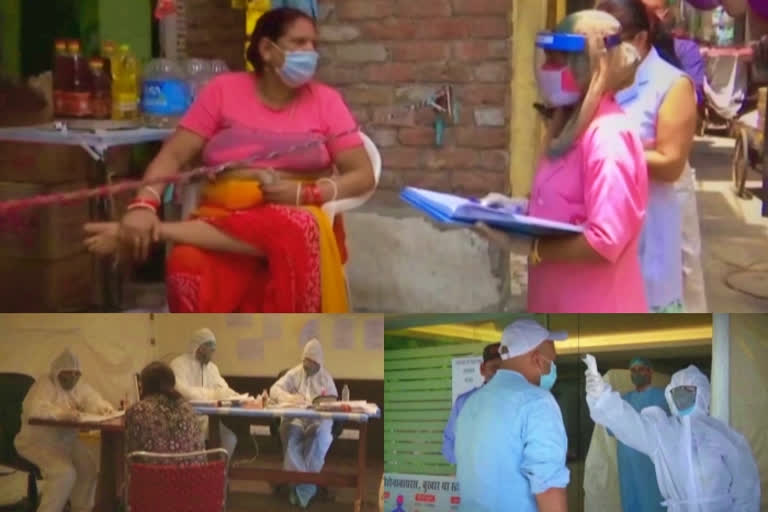Mumbai (Maharashtra): Dharavi considered as Asia's largest slum was once recognised as a coronavirus hotspot in Mumbai but since last one month it has reported a steep decline in the daily number of COVID19 positive cases and deaths.
The reduction in the number of corona patients in Dharavi is the fruits of combined hard efforts of Municipality, police, health workers and NGOs which emphasised on tracing and putting affected people into quarantine.
Union Health Ministry has also lauded the Brihanmumbai Municipal Corporation for ensuring a steep decline of daily Covid-19 cases in Dharavi from an average of 43 in May to 19 in the third week of June. Following this, many states including Delhi were asked to take a clue from Dharavi success story.
People in Dharavi are forced to live in a compact space and almost everyone comes on the road several times during a day. Hence, there is hardly any 'room' for pressing the people to stay indoors or to maintain social distancing.
Covering a population of more than one million people residing in over one lakh slums, it was a mammoth task for the authorities to implement this pattern as observing social distancing norms here in Dharavi is next to impossible.
Read:| How Dharavi, Asia's biggest slum went from coronavirus hotspot to model ?
During the early days, people were afraid of coming forward and reporting about COVID symptoms.
Mumbai municipal corporation then decided to reach out to people with the help of private doctors who are their family doctors as well. These family doctors charge them with lesser fees and develop a close bond with people by gaining their trust.
In the view to gear-up COVID testing, 'fever clinic' was established where suspected patients are being checked by doctors and contact sheets are filled up.
Speaking exclusively with ETV Bharat, Dr Anil Pachnekar discussed the Dharavi Mission to contain the spread of coronavirus across the region.
Dr Anil Pachnekar an official of Indian Medical Council has been practising in Dharavi for past 35 years. He said, "In about one week, 47,500 people were screened in door-to-door searches. Out of these, some 1100 were sent to institutional quarantine and about 150 of them, who were found positive in the subsequent tests, were sent to hospitals."
With the implementation of nationwide lockdown, over four lakh migrant workers left to their native place, which in-turn assisted BMC to take appropriate steps as the area remained less crowded.
Backing up preventive measures, Brihanmumbai Municipal Corporation (BMC) administration increased the number of COVID testing in fever clinics, conducting door-to-door surveys, arrangement for proper quarantine facilities, creating effective awareness over preventive measures of COVID19 by regular hand wash, hand sanitization and use of face masks along with regular spraying of disinfectants in the region.
Read:| Dharavi coronavirus cases exceed 2000 mark
While talking with Deputy Municipal Commissioner of BMC Kiran Dighavkar, it was revealed that more BMC health workers and mobile vans were pressed in for work. The quarantine centres were set up within Dharavi itself.
"People felt safer because of this. They did not have to go far away places. The issue of making people stay inside the containment zone was also dealt with efficiently. BMC distributed 21,000 food packets for lunch and dinner so that people did not have to come out for food. Their other needs were also taken care of," Dighavkar said in a conversation with ETV Bharat.
Senior Police Inspector Ramesh Nangre said, "Several NGOs and organisations including CREDAI-MCHI and Bharatiya Jain Sanghatan also joined the movement. The role of local police was also proved to be very crucial. Recorded messages in multiple languages were played from mobile vans and police patrol vans to persuaded the people to cooperate. Police personnel were continuously kept on the toes and they were made to take out route marches in every lane and bylane of Dharavi."
With passing time, Dharavi has become the heart of Mumbai. The community spirit in Dharavi also played a vital role in winning the battle against COVID as lack of space in daily life forces the people to live together like a big family. Once, people were taken into confidence the contact tracing became comparatively easy as people could not hide their symptoms.
During the mission, about 33 policemen got infected. One officer also lost his life to COVID. But still, they kept their morale high and are still fighting.
As the government is facing a shortage of frontline COVID warriors, the government need to push more manpower to deal with the situation. It was much easy in the case of Dharavi, as people living here take care of each other hence lessening the burden of authorities.
All these efforts ultimately helped Dharavi to witness a drastic decrease in the number of coronavirus cases and stop the spread of the infection.



